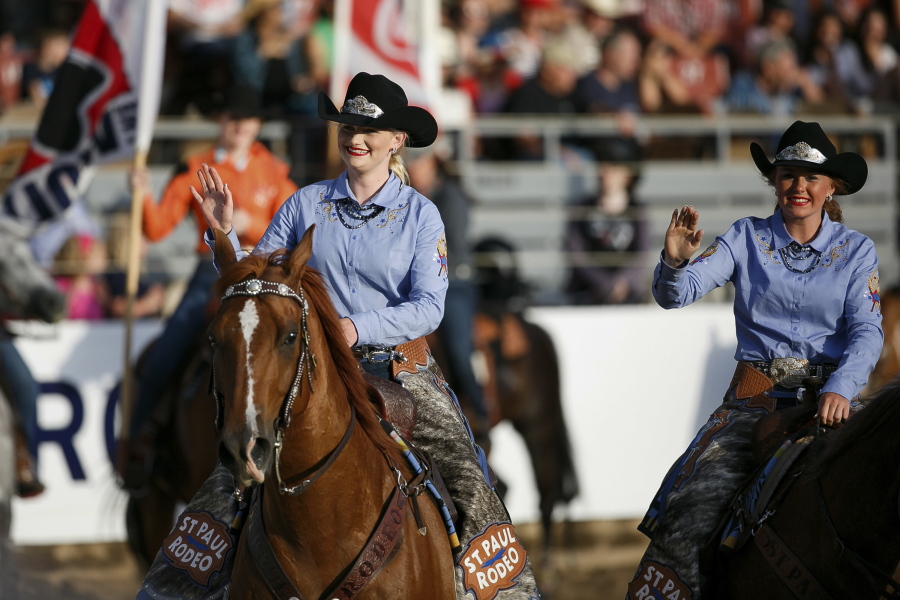SALEM, Ore. — At 4 a.m. on a Saturday morning in early June, three young women woke for an epic day.
Melanie Atchison, Morgan Spear and Britney Norby spent an hour applying makeup and getting their matching outfits looking perfect because thousands of eyes would be trained on them.
The three traveled to Portland with their horses to ride in the Portland Rose Festival’s Grand Floral Parade — smiles ever present and not a curl of hair out of place — then drove three hours to Sisters to ride in that night’s Grand Entrance of the Sisters Rodeo.
They were announced over and over as the Royal Court of the St. Paul Rodeo.
“I had a little kid come up to me and say, ‘She’s the queen of ponies,'” said Atchison, better known as St. Paul’s queen of its Royal Court. “I’m like, ‘Oh my gosh, I guess I am.'”
There’s more to rodeo royalty than being a pretty girl who smiles so much it hurts, but that can be an occupational hazard.
Since March the Royal Court of the St. Paul Rodeo have been making appearances nearly every weekend, going to agricultural festivals, parades and rodeos.
The week prior to their rodeo they made appearances nearly every day — radio interviews, speaking at Kiwanis Clubs and appearing in person almost daily.
They continue to make appearances after the rodeo ends.
And they don’t get paid for their time.
“It is just about a full-time job,” said Cindy Schonholtz, general manager of the St. Paul Rodeo. “They have to really love the sport of rodeo and really love the rodeo they’re representing.”
The roles that Atchison, Spear and Norby fill for the St. Paul Rodeo are the same that women have been filling for more than 75 years.
Royal courts may vary by rodeo, but they are all the face of the event they represent.
For some, being a member of a rodeo court is more than a commitment. It’s a legacy.
“I think that being queen all those years ago means more to me now than it did then,” said Shirley Ernst, St. Paul’s queen in 1944. “I am so proud of that.
“Even if we didn’t do near as much as they’re doing now, we did what we could, and we had a good time doing it.”
Some rodeos have no court, some have one, three or even five members. Some are called ambassadors instead of royalty and all have varying requirements determined by tradition.
At St. Paul, women must be between the ages of 17 and 23 at the time of the rodeo, unmarried and pay all expenses for their horses, among other requirements.
St. Paul holds a one-day tryout each fall when the court is chosen.
Those selected make a huge commitment.
“The contestants that are involved in the rodeo are not always on hand, they’re travelling,” said 1991 St. Paul queen Karen Tuck. “But it is unique because we want the image of these girls to represent the St. Paul Rodeo.”
At St. Paul, equestrian abilities are highly valued for the royal court.
These women have to be able to ride horses through all types of conditions: a trot down an asphalt road in hot sunshine, at full gallop through a dirt arena under spotlights as well as being able to keep their horses perfectly still and quiet for the national anthem.
And they have to maintain an image while doing it.
“The first parade, we had to smile through the whole thing,” said Atchison, a Cascade High School graduate. “My lips were literally trembling. I would have to stop and act like I was talking to my horse to get them to stop and smile again.”
Possibly the most important skill for the rodeo court, and the one that they practice constantly, is public speaking.
Norby tells a story about when she was a child and her aunt gave her the belt buckle she earned from being a princess at the Washington County Rodeo.
Norby made a bet that she would win her own rodeo belt buckle one day and pass it on.
She admits that a year ago she would never have been able to tell that story.
“I probably would not even be able to talk to you,” said Norby, a princess. “I probably wouldn’t be able to come up to you and shake your hand.”
If the royal court members chose, they can continue a path where they compete in the Miss Rodeo Oregon pageant and then continue on to the Miss Rodeo America pageant, which gives scholarships to the winner.
That takes a huge commitment that not everyone can make.
“It’s just one of those things where I’m going back and forth,” Atchison said. “Do I want to do that or do I want to continue on with college and a career? I go back and forth all the time.”
Everything is glitter and sequins for the women who can also be spotted painting walls or hanging up signs.
Each rodeo court member finds their own reason for taking on the commitment, but the universal reason is that they want to be someone people look up to.
“It’s pretty much filling that dream of being a role model,” said Spear.
“Running into an arena as they do grand entry as they announce St. Paul, as a representative of St. Paul, it’s eye opening.”



